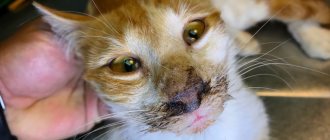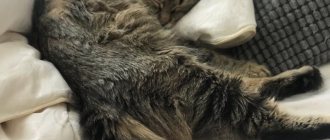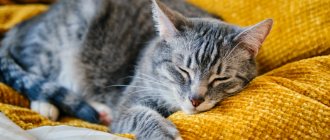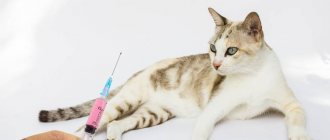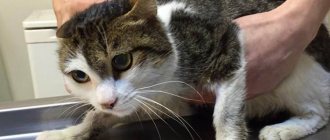Not every breeder of furry pets knows that distemper occurs in cats. This common viral disease occurs not only among dogs, as many of us are accustomed to believe. In most cases, feline panleukopenia (this is the official name for this disease) ends tragically for the pet.
What is feline panleukopenia?
“Chumka” is a popular name. This is the name given to various infections that are characteristic of different types of animals, but have common features - they are very contagious, sick cats often die or have a difficult recovery. In addition, cat distemper is sometimes similar in its course to canine distemper, to which dogs are susceptible. Until 1928, it was even believed that these were the same disease, but their pathogens were different, and cats did not get canine distemper, and vice versa.
The causative agent of the disease is the Panleukopenia feline virus , which belongs to the parvovirus family. Veterinarians and virologists call feline distemper panleukopenia, or infectious gastroenteritis.
The first scientific name describes a characteristic symptom of the disease - a significant decrease in the number of all types of leukocytes in the animal’s blood. The second is a set of symptoms noticeable to the owner: this is an upset stomach and intestines, moreover, caused by an infection, that is, contagious.
It would seem, how is the decrease in the number (up to complete absence!) of leukocytes in the blood connected with inflammation of the gastrointestinal tract? The fact is that the causative agent of panleukopenia needs cells that divide as quickly as possible to reproduce. And these are bone marrow cells, especially those that produce leukocytes (at first the virus causes accelerated production), epithelial cells of the stomach and intestines, fetuses and newborn kittens. But since division is a process characteristic of cells of any tissue of a living organism, the disease actually affects all organs.
How to identify the disease
At first, the owner of the animal perceives distemper as poisoning, but after a few days he has to consult a veterinarian.
To confirm the diagnosis, a specialist conducts laboratory tests of blood and stool. If there is a decrease or absence of leukocytes in the blood, and microscopic remains of parvovirus in the feces, then the diagnosis of feline distemper is confirmed.
Important!
Symptoms of panleukopenia resemble both poisoning and paneratitis, feline leukemia, and immunodeficiency virus, so it is important to provide your veterinarian with detailed information about the course of the disease.
How is distemper transmitted in cats?
The incubation period of distemper in cats - the time when the animal has already become infected, but does not yet show signs of the disease - ranges from 2 days to 2 weeks.
The virus is stable in the external environment: at a temperature of 60 degrees it takes an hour to destroy it, and in addition, it is not afraid of standard disinfectants. Alkalies and modern disinfectants that affect viruses help cope with infection indoors.
The virus can exist in the feces of sick animals and virus carriers and retain the ability to infect for up to a year. Given the peculiarities of the course of the infection, the feces of sick animals may end up in the most unexpected places.
Note! Panleukopenia is transmitted only between members of the cat family (all, including wild ones). People and other pets do not get sick from this, but they can transmit the virus through accidental contact with infected secretions - feces, nasal mucus, and so on.
There are the following ways of contracting panleukopenia:
- oral – when any secretions of sick animals enter the cat’s oral cavity;
- intrauterine infection - from a sick mother to the fetuses, which most often leads to the intrauterine death of kittens or the birth of non-viable animals;
- transmissible infection through flea bites and ticks.
The most common route of transmission is the first, which is also the most diverse. Infection occurs through direct contact of animals, through care items, shoes or clothing of owners, hair from dogs that have access to the street, and so on. Any object that could come into contact with the feces of a sick cat or a virus carrier is potentially dangerous.
How does a virus become infected?
As we said earlier in our article, the Felina Panleukopenia virus:
- very resistant to aggressive environmental factors;
- excreted in the feces of sick animals or recently cured animals.
Feces that may contain this pathogen are:
- animal saliva;
- cat urine;
- feces
One of the possible methods of infection is contact
Infection with distemper in carnivores is typical not only for representatives of small and medium-sized breeds of the cat family, but also for large animals, for example:
- Maine Coons;
- servals;
- caracals;
- other big cats that are so popular today.
So how does one become infected with a disease that, as it turns out, affects absolutely all cats? Here's how:
- the animal must come into direct contact with a substance containing the virus, that is, the biological fluid of another cat, in which case infection will occur by contact;
- provided that the infection is carried out through droplets of saliva, then it will occur by airborne droplets;
- the third route through which infection will occur is intrauterine, when a pregnant mother cat transmits this disease to her babies;
- through contact with parasites, when any blood-sucking insect or endoparasite attaches to your pet and bites it, at the same time transmitting a virus to it (mosquitoes, fleas, lice eaters);
- through a person, when the owner brings home on shoes or clothes particles of a substance containing inside the virus that causes canine distemper, thus even indoor animals can become infected with this dangerous disease.
Both purebred and outbred cats can get distemper, and the size of their body also does not matter
The greatest likelihood of contracting distemper occurs in those animals that become infected with the Felina panleukopenia virus by contact, that is, by sniffing, as a rule, feces defecated by a carrier of the virus.
The impact of the disease we are interested in primarily has an extremely negative effect on the animal’s blood, since when entering the body, the virus is primarily mistaken for:
- decrease in the number of leukocytes;
- the production of a toxin, which is then sent to the organs and destroys them.
First of all, the following are exposed to the negative effects of this disease:
- inner mucous surface of the intestine;
- animal heart muscle;
- lungs and respiratory tract;
- Bone marrow;
- lymphoid type tissues.
Damage to the above segments of the body leads to the animal developing primary disorders:
- dehydration;
- heart failure;
- disturbances in the functioning of the gastrointestinal tract, etc.
The older the animal, the more likely it is that it will survive this disease and also vice versa, the younger it is, the more likely it is that it will die.
Among all age groups, it is kittens that are practically unable to resist the disease; among a litter infected with the disease, usually no more than 10% of its members survive. In adults, mortality, despite the more significant strength of immunity, is also not at all small. So, of all the sick animals that survive:
- from 30%;
- up to 60%.
When infected with carnivore plague, the death of the animal occurs due to:
- severe dehydration of the body;
- heart muscle failure;
- the influence of secondary infections associated with the disease.
It is believed that animals aged approximately 2 to 6 years are least susceptible to the disease, since during this life period their immune system works best, while after six years it begins to weaken, and accordingly the cat’s protection is significantly reduced.
According to statistics, cats aged seven to eight years suffer from distemper as often as young animals.
The highest risk group is represented by kittens whose age ranges from several weeks to a year. By the way, if the disease is transmitted from the mother directly to the fetuses inside her womb, unfortunately, most often, the kittens die at the birth stage, or literally a couple of days or hours after birth.
The following phenomena also often occur in pregnant bitches with panleukopenia:
- miscarriages;
- mummification of fruits;
- resorption of embryos, etc.
There is no hope that your sick cat will give birth to healthy or at least viable kittens in the long term.
Symptoms of plague
Panleukopenia has a number of symptoms, which in most cases can be used to suspect the disease.
- lethargy (significant decrease in activity) of the animal;
- refusal of food and water, while there is no interest in food, but there is interest in water;
- an increase in temperature to 40-41 degrees in the first days of the disease and a decrease below 37 degrees subsequently if the course is unfavorable;
- vomiting and diarrhea with a specific, extremely unpleasant specific odor;
- the color of the vomit is first yellow, yellow-brown, then mucous, possibly mixed with blood;
- the stool is liquid, at first yellow-brown, mushy, then lighter, up to transparent mucous;
- abdominal pain, which manifests itself in positions unusual for cats - lying on the stomach with outstretched limbs, sitting, hunched over;
- cats often sit near a bowl of water, but do not drink;
- during periods of high temperature, animals look for cool places, and when it recedes, they look for warm ones;
- upon palpation, the intestinal loops are swollen, inflamed, inactive, and vomiting often occurs after palpation;
- sounds of rumbling and splashing come from the stomach;
- the coat is tousled, dull, the skin loses its elasticity.
The most important laboratory symptom is a change in the leukocyte formula. Neutrophils, which multiply most quickly during the inflammatory process in the body, can drop to zero, but more often it remains within 3...4 × 109. In the early stages, only very old cells can be detected. There are relatively few eosinophils and basophils in the blood, and they too may disappear.
The number of red blood cells may also decrease, but this is not always noticeable, since the hematocrit (the ratio of blood cells to its plasma) increases due to severe dehydration, despite the fact that there are fewer and fewer blood cells. Lymphocytes most often remain normal or slightly increased, and sometimes these are the only leukocytes that can be detected.
Many of these symptoms also appear in other diseases. However, all together they give a fairly typical clinical picture, characteristic specifically of acute panleukopenia. Unfortunately, this disease has a number of other forms.
The pneumonic form of feline distemper occurs with damage to the eyes, mucous membranes of the nasal and oral cavities, bronchi and lungs. In this case, there may be no symptoms indicating damage to the gastrointestinal tract, but everything else remains, and purulent discharge from the nose and eyes, redness of the mucous membranes of the mouth and nose, cough, shortness of breath, and heart rhythm disturbances are added.
The hyperacute, or fulminant form is a sudden severe illness that turns into agony and death within 1-2 hours or less. It is extremely dangerous because the disease can rarely be recognized in a timely manner, which means that other cats are also in danger.
Subacute form - the symptoms are smoothed out, the disease usually lasts 3-4 days and ends with recovery without treatment. This course is typical for animals that have been repeatedly vaccinated against panleukopenia. An important feature of this course is that animals that have recovered from the disease remain virus carriers for a long time and are dangerous for other cats.
Hidden form - the animal is practically healthy in appearance, but there may be a slight decrease in activity, appetite, and mild stomach and intestinal upsets. In this case, the cat releases the virus into the external environment. It's only dangerous to other cats. Many veterinarians believe that this is a latent form - not a disease as such, but one of the types of carriage of the virus.
Treatment, feeding during the recovery period
The veterinary clinic should prescribe complex treatment, including etiotropic drugs, and also prescribe symptomatic drugs to relieve symptoms. A medicine, a sodium chloride solution, should be administered intravenously to reduce dehydration and relieve intoxication.
The course of treatment must include:
- Antibiotic therapy - to kill bacteria in the microflora. The immune system of an infected pet practically does not work and all the bacteria that enter the stomach are activated. To neutralize them, antibiotics must be used. The dose and combination of drugs must be selected by a doctor; as a rule, they are administered intravenously.
- Antibodies that are contained in serums and globulins. They are used to neutralize viruses. It should be borne in mind that they are effective only at the onset of the disease and as a preventive measure.
- Drugs that stimulate the immune system, such as interferon.
- Salts leave the body along with vomiting, so it should be stopped. Metoclopramide helps suppress vomiting; you can also use Cerucal.
- Distemper is accompanied by severe abdominal pain and fever. You can alleviate the animal's suffering by using painkillers and antipyretics, and you should also give antispasmodics.
- During this period, the animal also needs vitamins and iron supplements.
Feeding during this period of illness is difficult, since the sick pet is in an exhausted state and refuses food. There is no need to force people to take food and water. He should be fed parenterally (through a vein).
When the animal develops an appetite, you should take care of proper nutrition. His diet should consist of five feedings a day. Food should be pureed, warm and light. Fermented milk products and puree soups with boiled minced meat will be useful.
Feline distemper, treatment with vodka
Judging by reviews from forums about folk remedies, treating a furry friend with vodka at home also gives results and brings positive results.
Note! Treatment with vodka should be resorted to if the cat has been infected for only a couple of days and the disease has not yet had time to spread throughout the body.
If vodka really helps an animal, the result will be visible immediately after 24 hours.
The proportions are as follows: one tablespoon of vodka, mixed with egg yolk. This mixture must be fed to the animal 2 - 3 times a day, one spoon at a time.
Diagnosis of feline distemper
In diagnosing panleukopenia, it is important to know whether the animal has been vaccinated, and if so, for how long ago. It is also useful for the veterinarian to know about your animal’s contacts with other cats.
Panleukopenia must be distinguished from diseases of the gastrointestinal tract that arise for other reasons, as well as from poisoning, intestinal foreign bodies and other equally serious diseases. To do this, it is necessary to conduct the following research.
Analysis for panleukopenia: this can be PCR (prepared in 2-3 days), ELISA (can be ready in a day) or a rapid test for this disease (the result will be immediately, but these tests have lower reliability than classical laboratory research methods) .
A general clinical blood test will show whether the cat’s leukocytes are high or low, that is, we are talking about serious inflammation or probable panleukopenia, and will also help determine the severity of the virus damage to the body.
A biochemical blood test is included in the standard of the initial examination of the patient and is necessary if the cause of the pet’s condition is not panleukopenia. If the rapid test for feline distemper is positive, it makes no sense, but if you have to wait for the results of virological studies, it is better to carry out this analysis. If distemper is confirmed, biochemistry will be useful later to assess the consequences of the disease on the pet’s body.
Ultrasound of the abdominal cavity can help to suspect infectious gastroenteritis before the results of virological tests and prescribe the correct treatment; with confirmed panleukopenia in the acute period, it has a low diagnostic value, but after recovery it is advisable to conduct this study.
Is the disease dangerous for humans?
The disease is transmitted only among cats. No cases of infection among people have been reported. Parvovirus is not dangerous to humans.
Distemper is safe for other pets. In dogs, this disease has the same name, but is transmitted by a different pathogen, so infection is impossible.
The virus brings anxiety and fear of losing a beloved pet. It is important to timely prevent distemper in cats. It is necessary to be attentive to your pet and to changes in its mood and behavior. It is recommended to see a veterinarian annually and follow the vaccination schedule.
An animal that has recovered from panleukopenia does not need a vaccine against distemper, because in this case, lifelong immunity is developed.
All information posted on the site is provided in accordance with the User Agreement and is not a direct instruction to action. We strongly recommend that before using any product, you must obtain a face-to-face consultation at an accredited veterinary clinic.
Treatment of feline distemper
Treatment of panleukopenia is difficult; as a rule, it is intensive therapy, and only in mild cases can you get by with supportive care. The optimal situation for the animal is placement in an infectious diseases hospital, but veterinary clinics provide such services infrequently, and they are expensive.
The primary task of a veterinarian in the treatment of panleukopenia is to maintain the vital functions of the animal’s body. The body can overcome the virus itself, but it does not always have enough time: animals are killed by intoxication, dehydration, salt imbalance, pulmonary and cerebral edema.
The main task at the first stage of treatment of panleukopenia is to eliminate dehydration and replenish the deficiency of electrolytes - minerals that are necessary for the proper functioning of the nervous and cardiovascular systems.
For this purpose, infusion therapy - droppers with saline solutions and glucose. The procedures are carried out in the acute period strictly intravenously, under the supervision of a veterinarian. The infusion rate must be adjusted depending on the patient's condition, otherwise a dangerous complication may occur - pulmonary edema.
Dehydration in panleukopenia occurs for two reasons. This is vomiting and diarrhea, with which the cat loses a lot of fluid, and poisoning with toxins produced by the body itself when faced with the virus. Therefore, the task of infusions is not only to replenish the deficiency of fluid and microelements, but also to facilitate the removal of substances that poison the cat. To enhance this process, diuretics are used.
In addition, it is necessary to protect the animal’s body, which is vulnerable after a virus attack, from bacterial infections. For this purpose, broad-spectrum antibiotics are prescribed as early as possible. They will not destroy the virus, but if microbes join it, the situation will become much more complicated, so antibiotics are necessary.
In Russia, special serums are used to combat feline distemper. The domestically produced immunoglobulin “Immunovet 1 In” showed a good clinical effect. However, the serum works better the earlier it is administered.
Symptomatic therapy is also used to support the animal’s cardiovascular, respiratory, and nervous systems. Vitamin therapy is carried out because the sick body is not able to obtain the necessary substances from food.
Severe anemia (low number of red blood cells in the blood) may require a blood transfusion. This is a rather complex procedure that is not performed in all clinics. Blood for transfusion is purchased from a blood bank or suitable donors are sought, and compatibility testing is carried out before the procedure.
Infection and effect of the virus
The parvovirus gastroenteritis virus is found in environments associated with animals that are sick or have recently recovered from distemper.
These media include saliva, feces, and nasal discharge.
The infection affects almost all breeds, including Peterbalds, Don Sphynxes, Ragdolls, Maine Coons, and even exotic cats such as Toygers, Egyptian Mau, Servals and Kuril Bobtails.
Infection with viral enteritis itself occurs in the following ways:
- By contact, when an animal interacts with a virus carrier or comes into contact with its saliva, feces or nasal discharge;
- Airborne, when a pet becomes infected with distemper through the air while being near an infected cat;
- In utero. This is how kittens from a sick mother can become infected.
- Through parasites - the virus can be transmitted by blood-sucking insects that parasitize infected cats, such as ticks, fleas and lice.
- Through a person. This refers to cases where the owner can bring the virus home on shoes or on his clothes. Thus, even those cats that always remain in the apartment can become infected.
A cat is most at risk of becoming infected through contact with feces of a virus carrier.
First of all, the parvovirus gastroenteritis virus has a negative effect on the blood.
Once in the body, plague sharply reduces the number of leukocytes, intoxicates and affects organs and tissues such as:
- Intestinal mucosa;
- Bone marrow;
- Heart;
- Lungs;
- Lymphoid tissues.
Damage to body systems leads to the development of heart failure, dehydration, and problems with the digestive system.
The younger the animal, the less likely it is to survive.
First of all, viral enteritis affects the cat’s blood leukocytes
The body of kittens is the least resistant to distemper - of those infected, only 10% of the litter survives.
Among adults, the mortality rate is lower, but still remains very high - of those who become ill, 30-60% survive.
So, the death of a cat occurs due to factors such as:
- Severe dehydration;
- Heart failure;
- The influence of secondary infections.
If we talk about risk groups, then healthy animals under six years of age are least at risk of being infected.
Since with age the animal’s immune system weakens and the body’s defenses are depleted, cats older than seven or eight years old suffer from distemper much more often.
Kittens under one year of age are at greatest risk
The most risky group are kittens between two and twelve months old.
If a pregnant female cat is sick, then enteritis can lead to the birth of non-viable kittens.
There may be cases of miscarriage, mummification, or resorption of the fetus.
Prevention of panleukopenia
There is only one way to prevent your pet from getting feline distemper - regular preventive vaccination. The anti-panleukopenia component is included in all modern cat vaccines.
You should not bring animals from the street into your home if you already have cats and especially if they are not vaccinated. If a new cat appears in the house, you need to keep it in quarantine for 2 weeks - without contact with other pets. If during this time the disease has not manifested itself, then the cat is probably healthy, but it is important to remember that it can be a virus carrier.
Caring for a sick animal
In addition to keeping the house clean and warm, there are a few more rules for caring for a sick cat:
- it is necessary that the cat is not disturbed over trifles, it is necessary to provide her with peace;
- all toys, bowls and tray should always be near the cat;
- water for the cat to drink should be boiled;
- During the treatment period, you need to use a diet: in the first two days, the cat should be fed only broths, for example, fish or meat;
- on the third day, you can try feeding the cat porridge with water, preferably rice or oatmeal, using small portions;
- if there is no vomiting, the amount of food can be gradually increased and boiled minced meat (chicken, fish or beef) can be added to the porridge at the rate of one teaspoon per 100–200 g of porridge;
- on day 5, you can try offering the cat a boiled egg;
- After 5–7 days of treatment, the cat can be switched to a more familiar diet.
If the animal eats industrial feed, then during illness it is recommended to give it food for problematic digestion (for example, Hill's, Eukanuba).
During the recovery period, it is advisable to use the following products:
- low-fat cottage cheese;
- fermented baked milk;
- boiled lean meat;
- boiled fish.
Distemper in cats - veterinarian answers to basic questions
What is distemper in cats?
Feline parvovirus enteritis or panleukopenia is a dangerous viral disease better known as distemper. Distemper in cats occurs as a result of the penetration of a highly contagious pathogen of viral etiology into the body. It primarily affects the animal's digestive tract, characterized by feverish conditions and problems in the respiratory system. At the same time, against the background of activation of the pathogen in the body, general intoxication is recorded.
The panleukopenia virus is a small DNA-containing virus, with a size of up to 25 nm. The pathogen has increased resistance to environmental factors. It can calmly withstand and remain infectious when exposed to a temperature of 60 degrees for 1 hour. It is resistant to digestive enzymes, chloroform and diethyl alcohol.
What are the symptoms of distemper in a cat?
There are several forms of panleukopenia in cats. There are fulminant, acute and chronic forms. Most often, distemper affects small kittens and it is in them that the fulminant form occurs, which is rarely treatable and ends in death. The death of the animal occurs on the third day after the onset of the viral disease.
In the chronic form of panleukopenia, there is a persistent disorder in the intestinal tissues, iron deficiency anemia and extreme depletion of the body. In the absence of timely assistance, the animal also dies from degenerative processes in the body.
Less commonly diagnosed is a latent form of feline distemper, which does not manifest itself with pronounced symptoms.
The main symptoms of acute panleukopenia are:
- increased body temperature;
- the animal's refusal to eat;
- the occurrence of nausea and vomiting (vomit is colored green or yellow, with admixtures of mucus or blood);
- the shade of urine changes - it becomes light orange or rich yellow;
- there is a change in the consistency of stool - liquid diarrhea, with a strong unpleasant odor, contains impurities of blood or fibrin strands;
- visible mucous membranes acquire a bluish tint;
- Inflammatory processes occur in the area of the conjunctiva and nasal passages, characterized by the appearance of copious discharge.
In the absence of timely treatment, the animal dies after a few days. Old cats can die from pulmonary edema caused by pathological changes in the body against the background of panleukopenia.
How long does it take to treat distemper in cats?
Depending on the severity of the pathological process, the duration of treatment will depend. In the case of an acute form of the disease, the course of therapy takes from one week to 14 days.
The basis of the therapeutic course is the suppression of the activity of viral agents and the destruction of secondary microflora. Pathogenic bacteria lead to complications of the disease. Doctors are also developing a treatment regimen to restore the impaired water-electrolyte balance and eliminate dehydration.
The use of etiotropic therapy is of decisive importance in the development of treatment tactics. For these purposes, special substances are used that have a stimulating effect on humoral cellular immunity. Interferons that have proliferative and immunostimulating effects are used.
Is distemper transmitted to other animals?
Panleukopenia is only transmitted from cat to cat. Dogs and other pets are not at risk of contracting this disease. Dogs and minks have another, serologically similar type of virus that causes parvovirus enteritis. This infection is also highly contagious and is fatal in young, unvaccinated puppies.
Is plague transmitted to people?
Distemper in cats cannot be transmitted to humans. If you have a sick animal in your home, you should not worry about the risk of infection. Panleukopenia does not have a clear geographical location and can occur anywhere in the world where there are favorable conditions for the development of a viral agent.
It is noted that panleukopenia is characterized by seasonality. The outbreak of the disease occurs on the first warm days after winter frosts. It is during this period that most fatal cases of distemper are diagnosed in domestic cats.
Where could a cat become infected with distemper?
The main source of infection with panleukopenia is infected animals, as well as cats with latent disease. After an animal has suffered from distemper, it remains a carrier of the infection for a long time. Transmission of the pathogen occurs mainly through direct contact of a healthy, but not vaccinated animal with an infected one. Also, the causative agent of the disease gets into the vomit and feces of a sick animal, from where other cats become infected. Transplacental transmission of the causative agent of feline panleukopenia infection cannot be ruled out. This means that an infected mother can become a source of infection for her unborn kittens. In this regard, it is very important that the cat, before the planned mating, is treated for worms, ectoparasites and vaccinated.
How dangerous is distemper in cats?
Distemper in cats, if left untreated, is fatal. In some cases, if a small kitten is infected, it develops a fulminant form of the disease, which, even with timely treatment, ends in the death of the animal. The hyperacute form leads to serious disruptions in the functioning of the body. So, a sick cat loses its appetite and refuses water. There is severe fearfulness, vomiting with foam, white or yellow. If there are disturbances in the functioning of the digestive tract, diarrhea with impurities of blood and mucus is observed. The skin loses its elasticity, the coat becomes disheveled and dull. The nervous form of plague leads to the appearance of tonic or clonic convulsions, often resulting in death. The animal dies within 1-2 days.
There are several forms of panleukopenia in cats. One of them is pulmonary. In this case, inflammatory processes develop in the area of the upper part of the respiratory tract, then the bronchial tree and pulmonary structures are involved in the process. In the area of the mucous membranes of the nose and eyes, specific films of a purulent nature appear. Often, against the background of a prolonged course of the disease, ulcers and minor hemorrhages form. Reducing the clearance of the nasal passages due to swelling and accumulation of exudate leads to increased breathing and shortness of breath. Tissue structures throughout the body lack oxygen. The cat is breathing frequently and may cough and sneeze.
With panleukopenia, not only the gastrointestinal tract and pulmonary system are affected. The cardiovascular system also undergoes degenerative changes. So, if breathing is impaired, the heart rate changes, tachycardia develops and, as a result, extrasystole. In advanced forms of the disease, which are practically the first signs of death, the heart rhythm becomes weaker, bradycardia progresses, and heart failure occurs.
Does distemper vaccination help cats?
The only truly significant method of preventing a cat from becoming infected with distemper is vaccination. There are many different vaccines on the modern pharmacological market. A veterinarian will help you figure out which vaccine is right for your pet after a detailed clinical examination. Vaccination against panleukopenia makes it easier to survive the disease without complications even if infected.
It is not recommended to vaccinate exhausted and clinically ill animals. It is prohibited to vaccinate cats during the period of bearing kittens and while feeding them. Little ones should receive their first distemper vaccination at the age of 1.5 months. This period is the most dangerous for young animals, as the risks of infection and death are very high.
Animals are re-vaccinated 3 weeks after the first vaccination. Further revaccination is carried out according to the vaccination calendar annually. Before making a vaccine, the animal must be freed from possible helminthiasis or external parasites.
Does a recovered animal have immunity?
Unfortunately, a cat that has recovered from distemper has an immune response, but it is very weak. It is better to carry out routine vaccination. Strengthening the cat's immune system is also of particular importance. To do this, you need to take care of the proper organization of the animal’s diet. An integral part of preventing infection with various viral infections, including panleukopenia, is regularly enriching the diet with vitamin and mineral complexes.
In order to prevent infection of a pet, it is necessary to ensure that the animal does not come into contact with stray relatives or known sick cats. Since the main route of transmission of the virus is through contact, it is necessary to ensure that the cat does not come into contact with outdoor shoes. Don’t forget about scheduled medical examinations of your pet at a veterinary hospital.
Treatment of distemper in cats
There is no single, truly effective drug for the treatment of plague. Therefore, in veterinary medicine, to treat a viral infection caused by parvovirus, complex treatment is used aimed at destroying the pathogen. Further in the course of therapy, important places are occupied by eliminating signs of intoxication of the body, preventing the development of complications in the form of a bacterial infection and increasing the overall resistance of the body to the effects of various environmental factors.
The course of treatment and dosage of drugs is determined by the veterinarian based on the individual characteristics of the patient - his age, state of health and degree of advanced disease. Interferons are used as antiviral therapy, proving their effectiveness in the treatment of viral infections.
Symptomatic therapy allows you to restore the disturbed water-electrolyte balance and relieve intoxication. For this purpose, the animal is injected intravenously with various solutions with salts and minerals. Diuretics allow you to quickly remove toxins from the body resulting from the activity of viruses. Painful sensations in the gastrointestinal tract are eliminated by prescribing antispasmodics.
Broad-spectrum antibiotics can prevent or eliminate the development of pathogenic bacterial microflora. As a rule, the entire course of treatment for uncomplicated panleukopenia takes about 2 weeks.
Traditional methods of treating distemper in cats
Most people try to help the animal on their own, listening to the advice of “experienced” people. A common remedy for distemper in dogs and cats is pouring vodka down the throat. Unfortunately, this not only will not get rid of the virus, but will also greatly harm the animal’s body. As a rule, the dose of alcohol is not calculated based on the animal’s body weight, causing serious intoxication. In addition to the intoxication that a cat’s body faces during distemper, it also needs to process a huge dose of alcohol. All this leads to dangerous violations and often increases the chances of death.
Author and presenter of the column: Veterinarian Igor Viktorovich Sanaev
Due to the large flow of incoming questions, free veterinary consultations are temporarily suspended.
Online diagnostic service for cat diseases >
Signs of gastroenteritis
Infectious gastroenteritis always begins suddenly, without long-term visible illness of the animal.
Intestinal infection is accompanied by:
- foul-smelling vomit;
- diarrhea (breakthrough diarrhea, often with blood and mucus);
- sharp intestinal pain;
- “jumping” temperature (from 41-42* to 37-36*);
- muscle pain;
- weakness;
- loss of interest in what is happening.
But cats die not from temperature fluctuations and muscle spasms, but from the inevitable destruction of internal organs in the absence of treatment and from dehydration - dehydration.
Dryness of the tongue and palate, absence or weakness of urination, general weakness, shallow breathing, coldness of the extremities, partial paresis (decreased muscle strength) are signs of severe dehydration of the body, requiring immediate intervention by a veterinarian.
An accurate diagnosis of whether cats suffer from distemper or whether there are other causes of severe intestinal upset must be determined by a doctor!
Independent attempts to cure an animal can lead to either temporary improvement (the disease will continue to develop in the meantime) or death.
It’s really bad if infectious gastroenteritis is associated with parasitic gastroenteritis (entomoses and helminths that cause persistent chronic diarrhea).
The causative agent of the disease
The feline distemper virus was first identified by French microbiologists Christopher and Verge in 1928. It is an isometric particle with a size of 20–24 nm, has one DNA helix, and belongs to the genus of parvoviruses. The virion (viral particle) is resistant to acids, chloroform, ether, phenol, trypsin, can withstand heating up to 56 degrees for 60 minutes, and remains active in the external environment for about a year. The Latin name is virus panleukopenia feline.
The antigenic composition has not been sufficiently studied; similarities of the virus with the enteritis viruses of dogs, minks, and cat ataxia have been discovered. On the third day after clinical recovery, specific antibodies are detected in the blood of cats, which persist for several years. After distemper, a cat secretes the virus for a long time in its urine, saliva, and feces.
